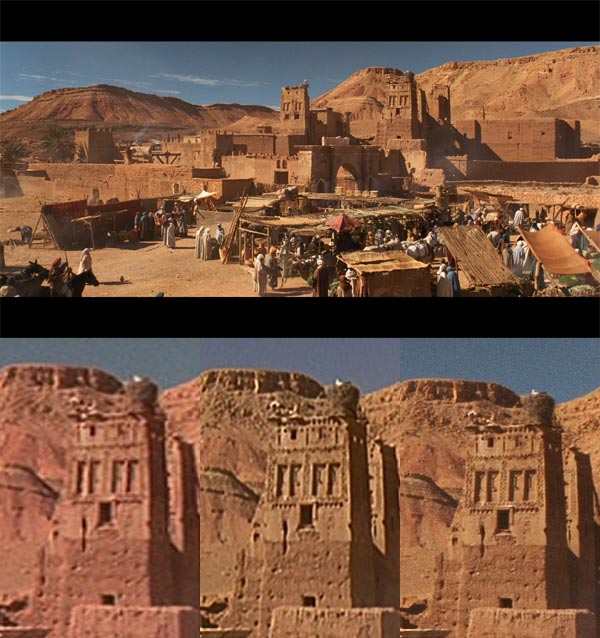 Picture:
Picture:  Sound:
Sound:  Extras:
Extras: 
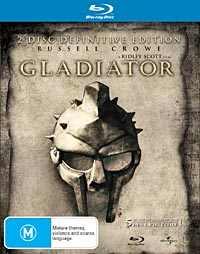
Download scan of review (JPEG, right click, Save As)
Movie:  Picture:
Picture:  Sound:
Sound:  Extras:
Extras: 
Yes, there are two versions of Gladiator available on Blu-ray, and in most respects they are very hard to tell apart. The boxes look the same. The special extras (spread across two discs) look the same, aside from the addition of 'pocket Blu'. Even the disc labels look the same! The version to be avoided has printed on its surface the identifier '28647.1/ST/G51/R0'. The one to be purchased carries the identifier '28647.1/ST/G51/R1'. Hard to tell apart.
Until you watch the movie. Then they become easy to tell apart.
The initial release of Gladiator in the US attracted a lot of criticism from Blu-ray aficionados. The charges: the application of edge enhancement and noise removal. Eventually a remastered version was released. That was released here as well, also eventually.
Universal's position was carefully worded: '[A]fter carefully revisiting the mastering process based on technical preferences expressed by a small number of enthusiasts we will be rolling out a slightly altered version of the Blu-ray. However, this is not a recall, as both versions are high quality and only slightly different. ... Consumer preferences are subjective-one version is not technically superior, but creative choices are made that distinguish how a source master is created which result in subtle differences in the product.'
My judgement is that the newer version is substantially better for the most part, thanks to the lack of edge enhancement. The former seemed glittery and edgy, with fine detail hard to make out on complex scenes. On the other side, on simpler scenes with large subjects (eg. close-ups of faces) it did have a certain superficial appeal thanks to seemingly sharper detail. Nonetheless, I found it a quite uncomfortable movie to watch purely on the grounds of picture quality, even though I like to think of myself as reasonably easy going. This was especially so at 1:11:55 in the movie (1:16:05 on the extended version). This scene has Crowe and Hounsou setting on a low wall with greenery some distance off in the background. The foreground seems to hover, disconnected from the rest of the scene, moving against it almost subliminally. It was as though the background were a matte, and there was a small vibration in the foreground.
Of course, this scene looks rock solid in the new version.
The two versions appear to have been taken from different scans of the movie, with slightly different framing between the two, a different colour balance and a different gamma. But the differences between the latter two are inconsistent from scene to scene. I have on my website (hifi-writer.com/he/bdreviews) comparisons between frames from the two versions (and from the Superbit DVD version) so you can see for yourself the differences.
Otherwise, both discs are identical. They have the original and an extended version of the movie, provided by means of seamless branching. The latter is preceded by a brief introduction by Ridley Scott in which he is pretty dismissive of the extended version. If you watch the Theatrical version, which is what he would appear to prefer, then you can catch up on the deleted scenes from the extras menu. This feature links to the same 13 files that are actually the seamless branches which are inserted into the movie to form the extended version.
The original disc gets a slightly higher average video bitrate than the remaster, although both are lower than average. Still, given the 2.35:1 aspect ratio, the 17.7Mbps seemed adequate.
Lots and lots of featurettes are scattered over the two discs, with the ability to select those of interest while the movie is underway and key them for later watching.
And there is pocket BLU. This demonstrates the power of the BD-Java programming language available to Blu-ray. Pocket BLU takes control of a BD-Live-enabled Blu-ray, and talks to a control app on your iPhone, iPad or iPod Touch over your home network, allowing the device to act as a remote control with arrow and transport keys. It also provides a time line for rapid navigation. Other features are available on some discs, but not this one. The implementation for this movie is presumably less because Universal only distributes it outside the US. One defect of the implementation is that the chapter markers on the time line are completely out of place.
 (Australian rating); Region Free
(Australian rating); Region Free
The following video bitrate graphs were generated by BDInfo. First, the original, theatrical version:
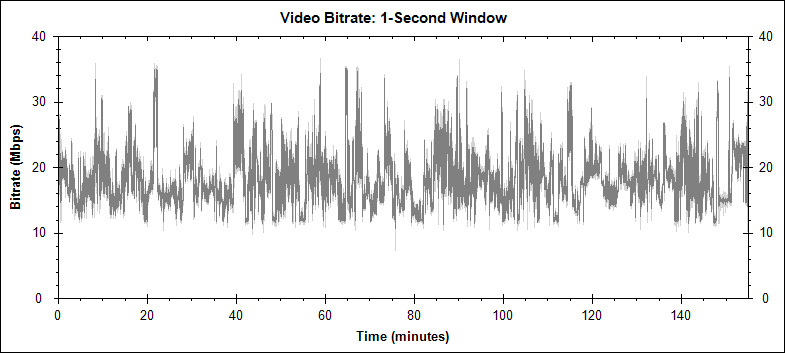
Then the original, extended version:
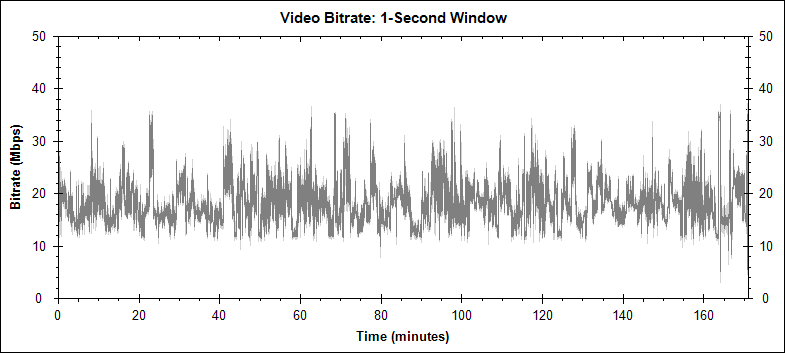
Then the remastered theatrical version:

Finally the remastered extended version:
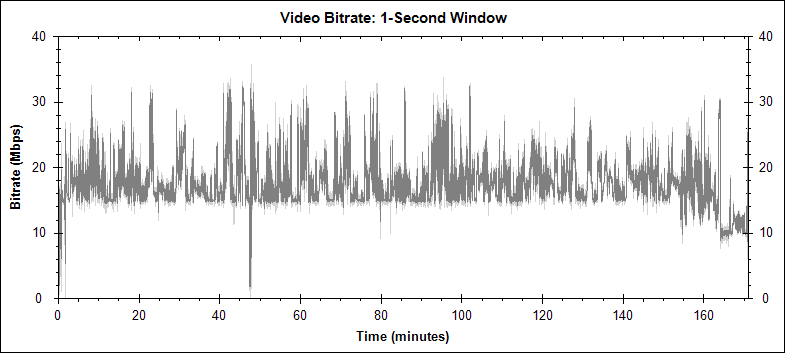
Flip the Blu-ray disc package over. If there is only one paragraph of text at the top above the picture, then this is the original release. If there is a second paragraph making mention of 'Pocket BLU', then this is the remaster (original top, remaster bottom):
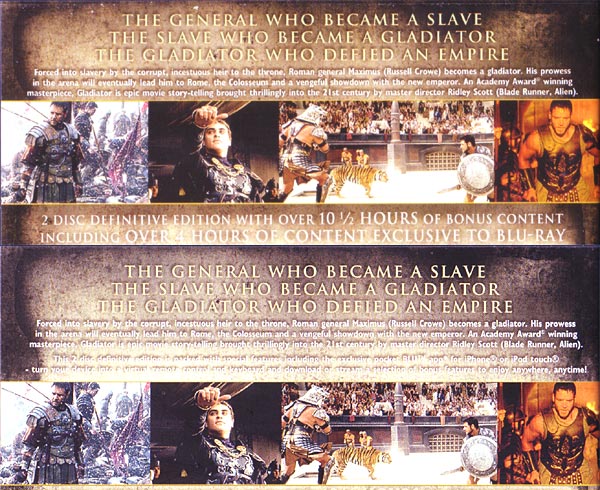
It may seem odd that a Universal title was supplied by Columbia, but back then Columbia TriStar handled DVD distribution for Universal in Australia and, I gather, in certain other places.
At the time Columbia TriStar was pushing its high quality SuperBit DVDs, and included a number of Universal titles such as this one, and Gladiator. So, basically, this DVD is about as good as it gets for the format.
The two Blu-ray versions should be similar to those released in the US. The first, which I'm calling here 'the original' was criticised by videophiles for poor quality. Subsequently a remastered version was released. The primary difference between the two was the application of edge enhancement to the first Blu-ray release. This had the effect of adding apparent detail in some shots, but causing a certain brittle appearance to the picture, and obscuring a lot of more complex detail.
At the top of each is the full frame (suitably shrunk down) used in the comparison, with three 200 pixel wide details from the frame placed underneath it. The left side is from the Superbit PAL DVD. The image was captured digitally from the disc. I scaled it in Photoshop, in order for it to be comparable to the Blu-ray version, to 1,920 by 1,080 pixels. The detail is from that last scaled version, and has not been rescaled again.
The middle one is from the original Australian Blu-ray while the right side is from the remastered Australian Blu-ray. Neither of these have been scaled at all. Different applications were used to capture the frames, so some caution should be exercised in judging colour and brightness.
For visitors from NTSC lands, generally the PAL DVD is just a touch sharper than the NTSC DVD.
First, before getting to the full comparison, let's look at this edge enhancement issue a little more closely. Here is a shot of a child which nicely illustrates it. I haven't bothered including the DVD in this short section, so it is the original Blu-ray to the left, and the remaster to the right.
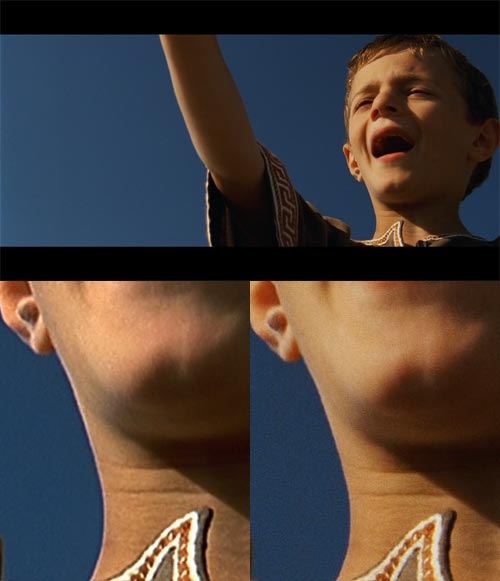
If you examine this carefully, you will see that with the remastered Blu-ray the blue sky meets the child's neck smoothly, whereas for the original it ends in a darker line, then a lighter line, then the neck. The is characteristic of edge enhancement. It adds a higher level of contrast right at the edge, making it seem sharper, but at the cost of altering the picture to either side of the edge. See how his tunic seems to have an almost cartoon-like outline in the original version.
In fact, at first glance this closeup of the boy looks better in the original than in the remaster. But look again, more closely. On the original Blu-ray his individual hairs are more crudely sketched, the glints from the sunlight overblown, and the gentle sense of fine pores in his forehead washed out with spurious noise:
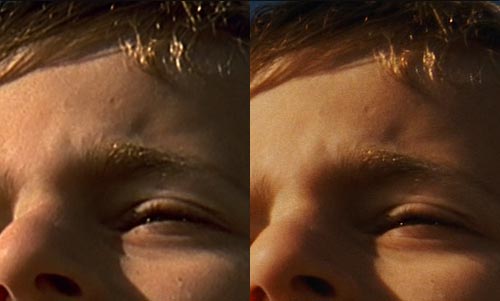
Don't believe me on that last point? Well, here is a closeup of the child's forehead, doubled in size for easier visibility:
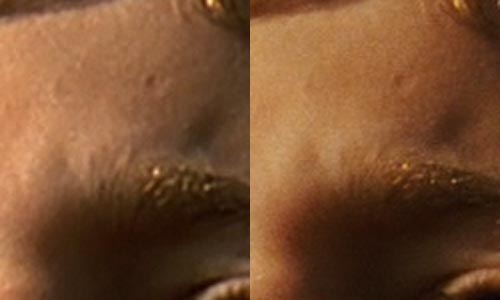
Now, let us return to the full comparison. Once again, the original Blu-ray looks a bit sharper and more detailed, but this is primarily due to the processing discussed above.

Here the original Blu-ray is clearly better than the SuperBit DVD, but it has a brittle edgy look. The remastered Blu-ray is smooth by comparison:
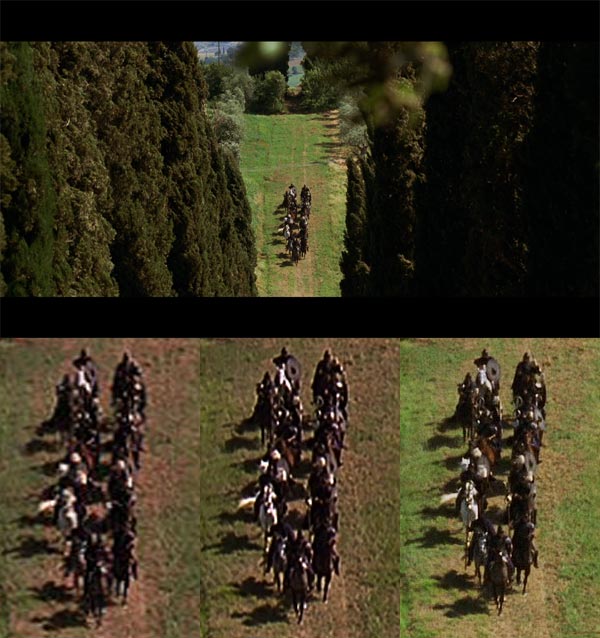
Now it's pretty hard to look at this next comparison without concluding that the remastering of the Blu-ray was totally worth it. It is as much better than the original Blu-ray as that was than the SuperBit DVD:
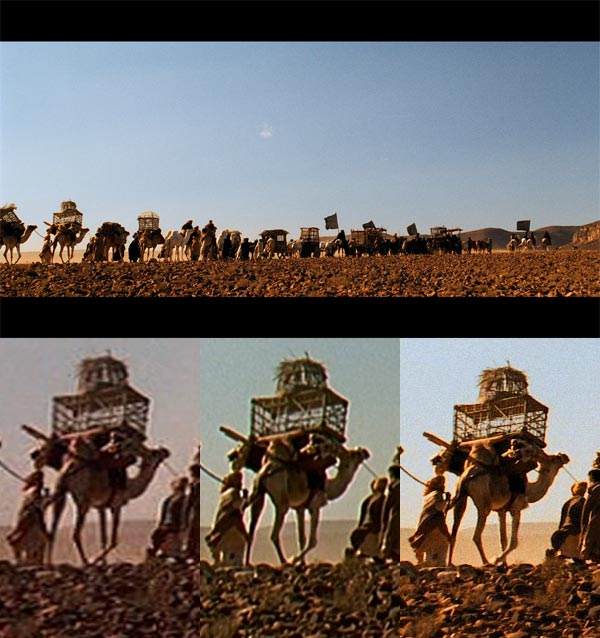
And here, once again, the dazzling detail of the remastered Blu-ray is quite missing from the original one, which has overblown, crudely sketched detail:
